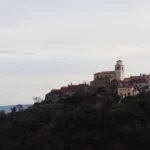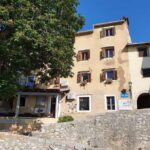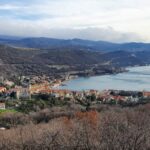Despite being the biggest cityof Kvarner region, situated in the middle of it, Rijeka was till recent less popular tourist spot than its neighbours Opatija, Lovran on north or Crikvenica the south side of Kvarner bay. Adding the beautiful Kvarner Bay islands in this story, Rijeka remains a much less known Kvarner touristic destination. However, that has started to change.
More and more tourists are discovering the many beautiful attractions of Rijeka and sharing them with friends and family. As a result, Rijeka is no longer known only for its port and carnival, but is now recognized as a vibrant city, similar to other central European destinations, full of museums, galleries, churches, and cultural landmarks.
Why should you visit Rijeka
Therefore, Rijeka was awarded as the European Capital of Culture (ECC) in 2020. It was the same year during the Croatian EU Presidency for the first half of it. Also, to be considered the largest Croatian port, Rijeka became the centre of a significant and extensive arts culture. It is filled by performances hosted by the best and most exciting artists from the global Croatian and European cultural scenes. However, unfortunately, due to Coronavirus disease in 2020, the same year when being awarded for being European Capital of Culture (ECC), many events were cancelled.
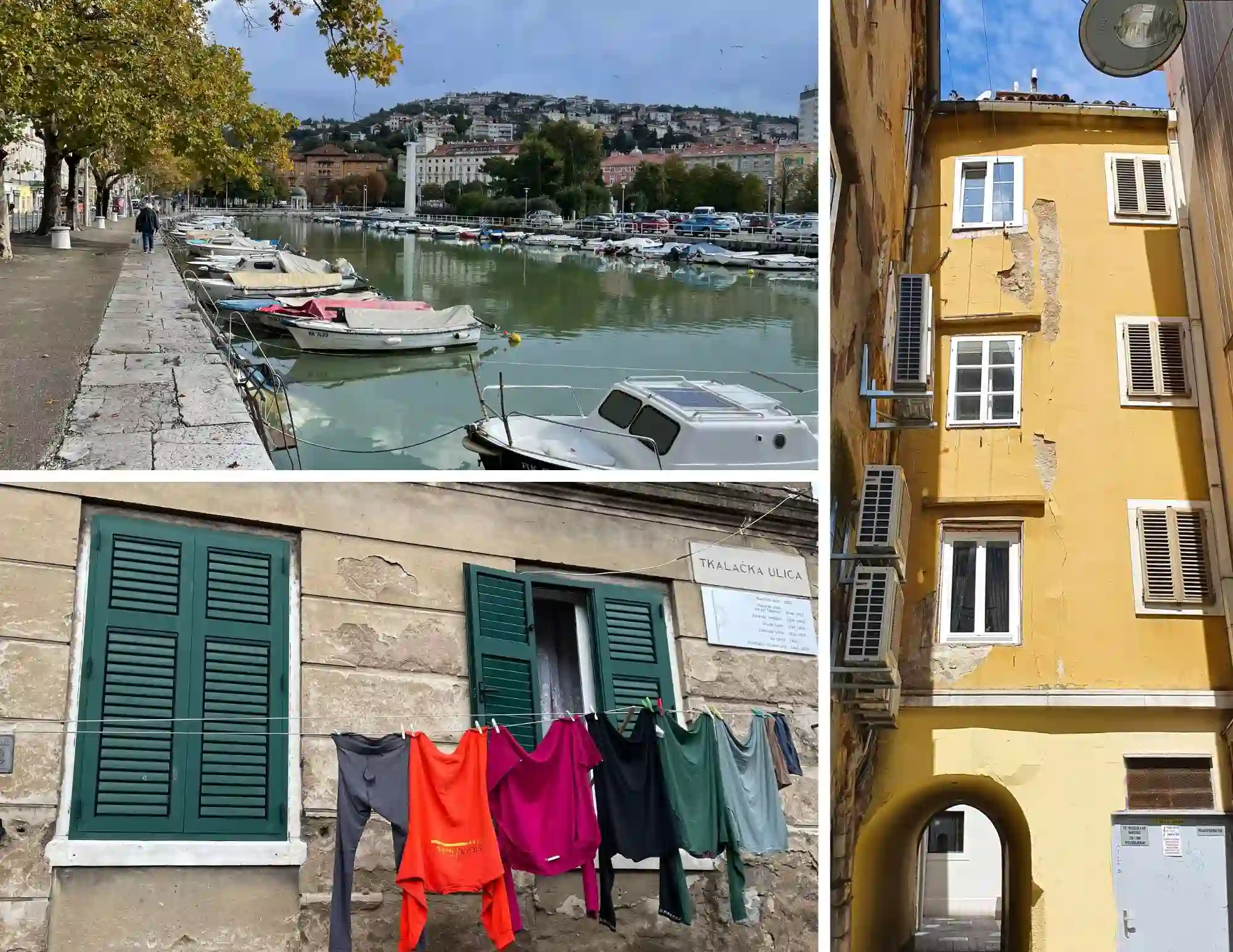
In the imposing city on Rečina, the European Capital of Culture (2020), you will be delighted with something new every next visit. As the city’s name says, Rijeka is a city that flows like its Rečina River. And it is in the right word of sense, connecting not only passers-by who wander through its culture streets but also the sailors that leave, sail, and return its port.
In Rijeka, you just can’t get lost. There are signs on every corner, leading the way to all its most prominent attractions. And they don’t lack. As the largest city of Kvarner Bay, Rijeka actually has quite a lot to offer. Tourists who seek getting a mixture of city experience and beautiful Adriatic surroundings would definitely feel for what Rijeka is alike – historically, culturally, and even by culinary. On the other hand, Rijeka remains central European authentic, keeping its past charm and a little bit of industrial presence.
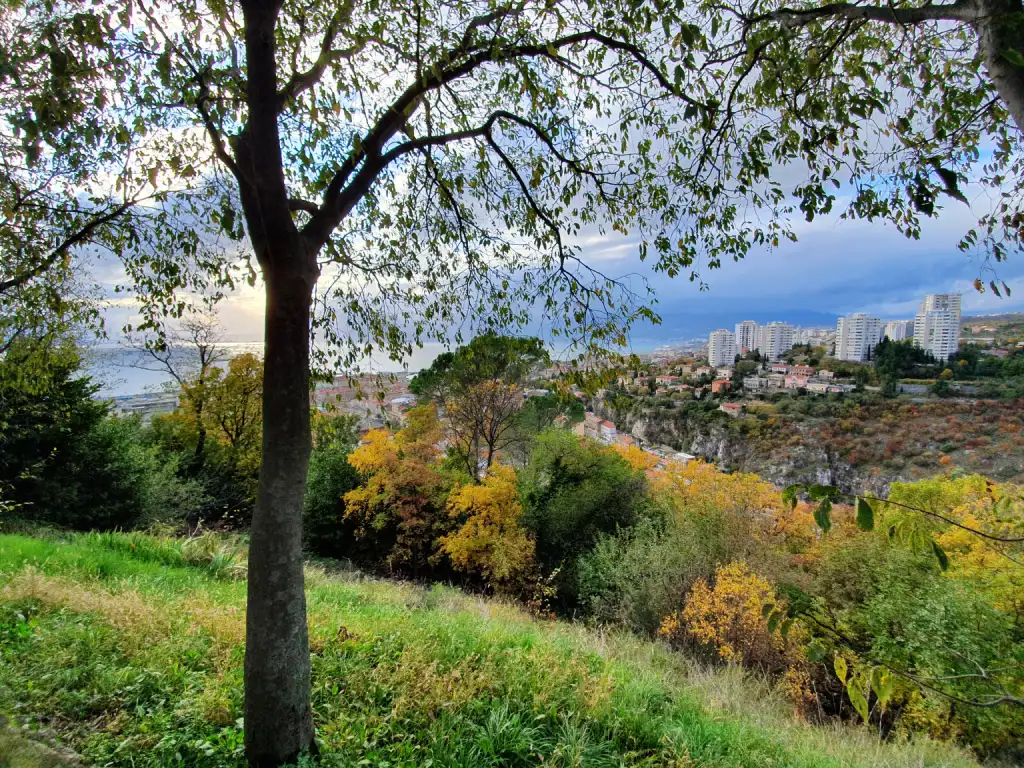
Here we prepared quite a lot of things to DO in Rijeka. Those are not only from heading into the fancy and old museums or galleries that we like it and the activities wemade in and beyond it, of course, all instead. I like Rijeka since there is no time when it’s not happening something new. Rijeka has a really lot to show, and you’ll mention itat a glance by your first sightseeing.
Rijeka in Croatian means “river,” and Rečina (it meansaugmentative for the river on local language), really flows through the town centre till out the sea. So, I recommend you do as we suggest to do, and enjoy a visit to museums or in coffee at Korzo, in memory of this culture area, awarded as the 2020 European Capital of Culture (ECC),
See Rijeka sights
It’s only enough to start exploring Rijeka, and you’ll notice that strolling all the passageways of this multi-cultural city is nowhere near enough time. I’ve been making a selection of items to visit while coming to Rijeka trip, so here’s a shortlist of things to do in Rijeka. Steep up to Croatian everyday life, interact with locals over a cup of coffee on Korzo, or a night out on this Rijeka’s bustling promenade, shop on the vibrant central market like a genuine Rijeka. So let’s explore Rijeka and feel like “Fiuman”, as the locals are named.
See Trsat Fort and Enjoy the best view of Rijeka
Since my visit to Rijeka, I recently returned to Trsat Castle—my second visit, the first being a childhood memory. Standing beside the Rečina Gorge atop this steep hill, it’s easy to understand why this spot was valued as a lookout in ancient times. Long before the Romans arrived, the Illyrians, who ruled much of the Balkans, had built a watchtower or fort here at the fortified site of Trsat.
During the 1500s, the castle changed hands between the Venetians and the Habsburg Empire. For a time, it was abandoned—until the 19th century, when it became the birthplace of Field Marshal Nugent, an Irish general in Austrian service (certainly a complicated era!). Today, the highest peak bears Nugent’s romantic touches from the late 1800s, though those are just a part of the story.
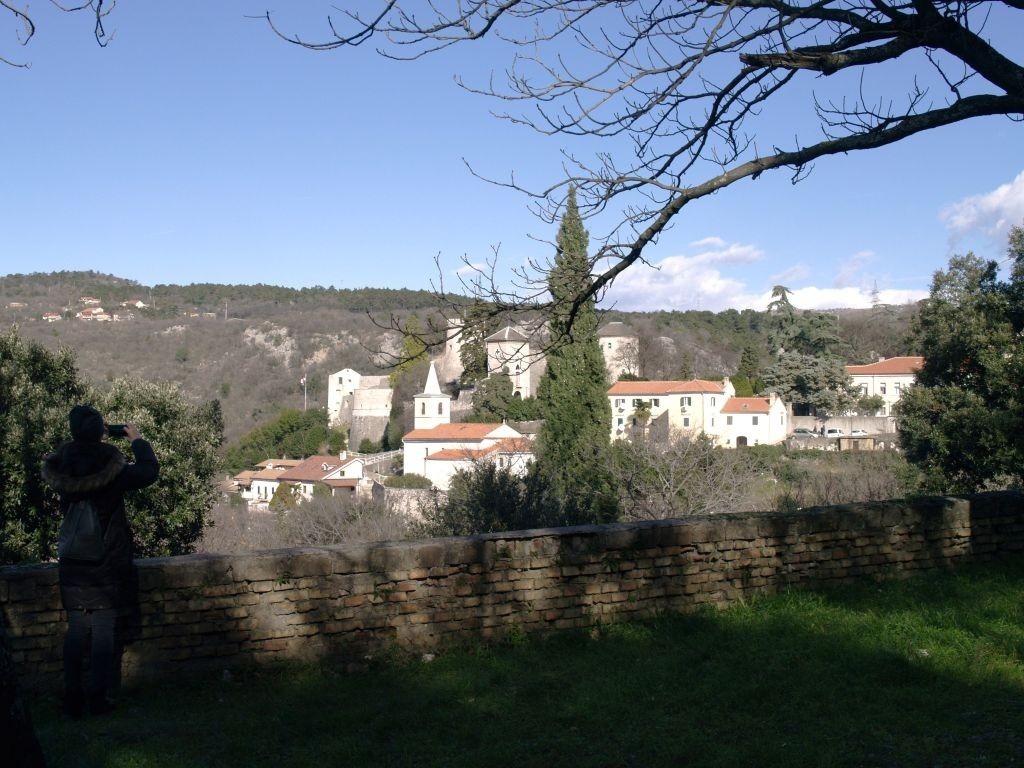
Because once you climb to the top of the fortification, the true reward is the view. From up here, Rijeka spreads below you like a living map, while the Kvarner Islands of Cres and Krk dot the sparkling Adriatic beyond. On a clear, sunny day, the mountains of Gorski Kotar rise in the distance, a dramatic backdrop to the city and sea alike.
I like to reach Trsat by climbing over 500 steps—the “Stairs of Petar Kružić.” You’ll notice them easily near the bridge at Delta, spanning the Rečina riverbed. From the center of town, the climb begins at the foot of the hill, winding up past Our Lady of Trsat, one of Croatia’s oldest Marian shrines, and onward to Trieste’s Tower. Since discovering this path, it has become my favorite way to reach the castle, though there are other options. A road climbs from the same starting point, if you prefer to drive, or a taxi can take you to the top in just five minutes. No matter how you arrive, Trsat Castle is a must-see—a place where history, views, and the joy of climbing converge.
Shrine Of Our Lady of Trsat
One of the Trsat hill point features is the church of St. Mary. A Baroque Church lays claim to being once been home to Mary of Nazareth’s house (1291). She is said to have been carried here by angles. Since was relocated to Loreto, Italy Mary’s house is not in the church today. A churchs interior grounds is decorated with a candle lights. This is why the locals come there daily to light candles and say a prayer. Candles can be purchased on site.
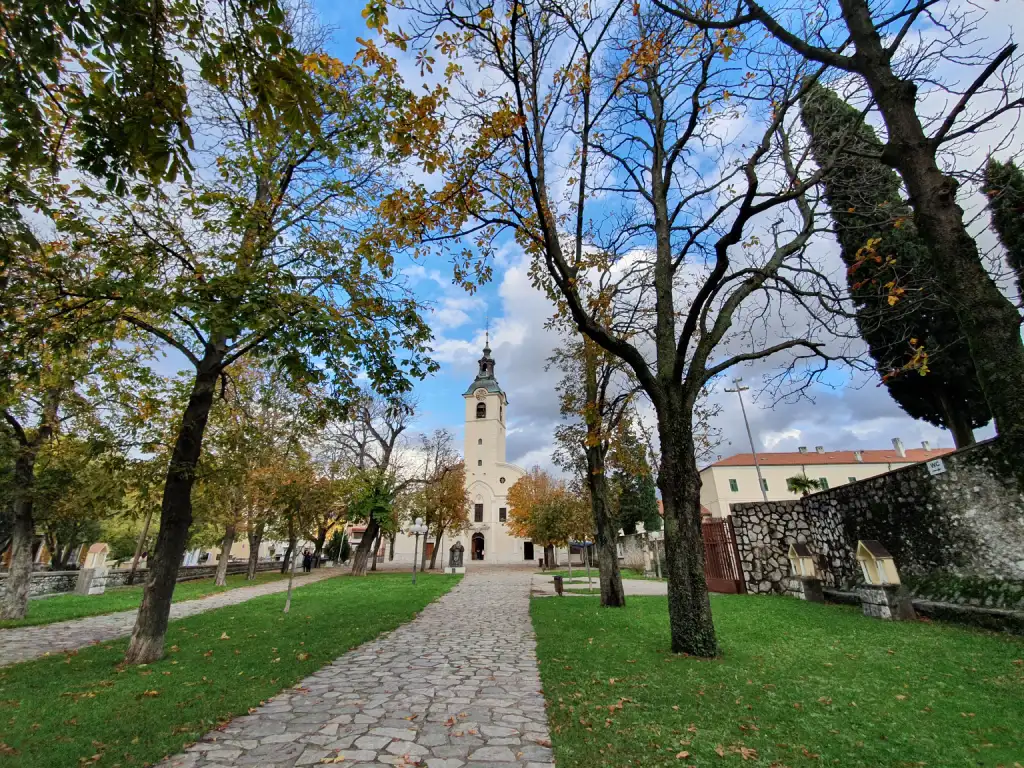
The beginnings of the shrine and the church are linked to the 13th century, while the church in its present form in the Baroque style was built in the 17th century by the Frankopans. This is is the oldest Marian Shrine in Croatia, and the shrine has the largest number of pilgrims in Western Croatia visiting each year, gaining one of the biggest processions in Croatia (update: follow the Covid-19 measures in Croatia for group gathering). Outdoors you’ll find a lush green park, with seating and the statue of Pope John Paul II. The statue was erected in honor of the Pope’s visit to the shrine in 2003. A great place to sit if you deceided to walk up the 500+ stairs (approx 20 mins). Beyond the park, there is a hill which has the Stations of The Cross.
Central Market
As it is a large traditional area of fruit, beans, cheeses and local items like lavender and plants, including sage and central market is a must-have experience. And almost every time I use to visit the central market while coming to Rijeka. Adjoining this market are two smaller pavilions where you’ll find meat, milk, street food and much more.
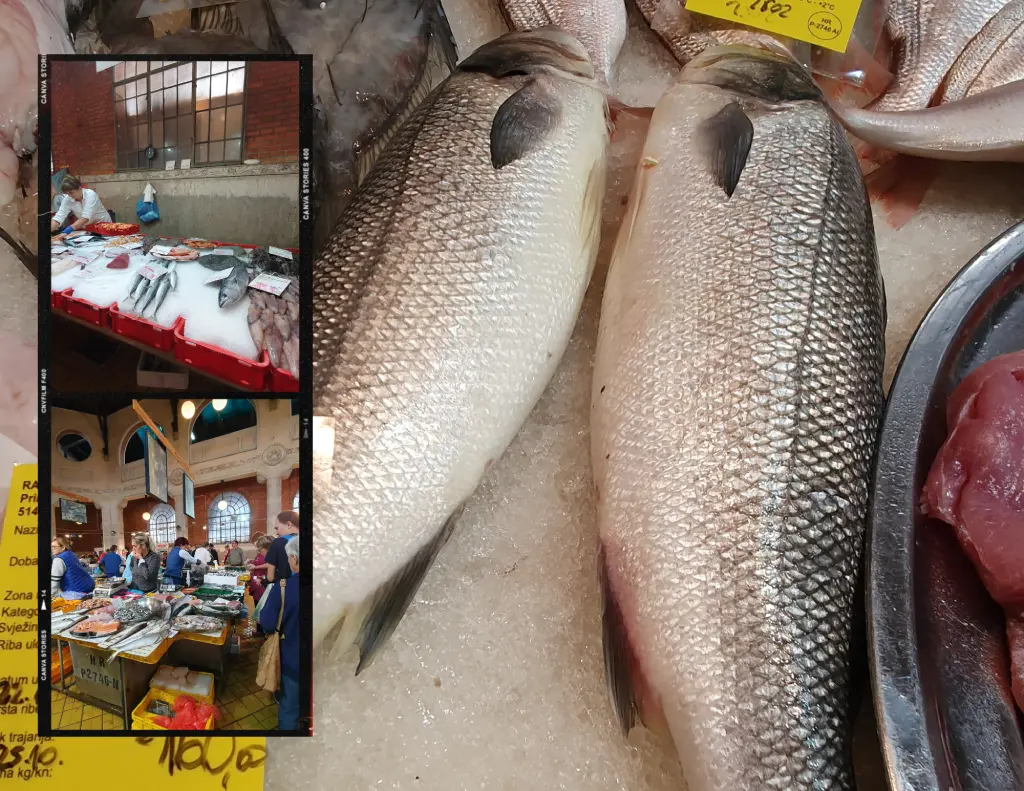
Furthermore, underneath, you’ll be surprised by the Rijeka fish market. The covered space inside the city market, Fish Hall Rijeka, is a stunning metal and glass art-nouveau architecture. It was built in 1916 on an earlier neoclassical structure, whose grand entrance is still in operation. Upon entering, you’ll notice a wide variety and numerous choices of wild fish from the Adriatic Sea. Once you found some freshly caught fish from the Adriatic Sea, head up to your Kvarner accommodation and prepare some lunch meal or party. Visit the city market with its Fish Hall and prepare the fish meal is must-do while in Rijeka, both for the full Kvarner experience and to stock up fresh produce.
Korzo
This street is paramount if you would like to feel the vibrance of everyday life in Rijeka. One of my favourite things to in Rijeka is strolling Korzo, a long and broad promenade lined with moderately priced shops and cafes. You could just sit with a cup of coffee or ice-cream at a table there, and watch the world pass by Korzo, the beating heart of the city and the centre of the city’s pedestrian zone.
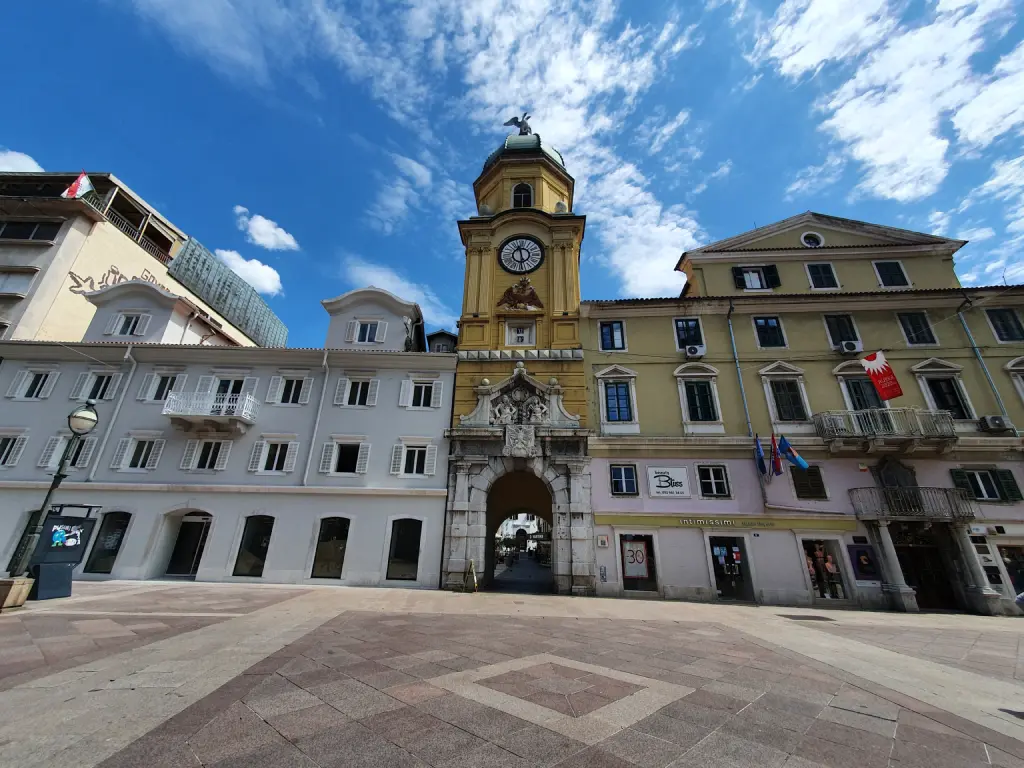
When the day changes into night, Korzo takes on a more energetic and youthful feel, and you can see couples heading out for dinner and some of the bars transforming into nightclubs.
City Tower Clock
The photography fans will like the Baroque City Hall, which is maybe the most emblematic building in the region. Situated right on Korzo centre, this is a sight you should not miss. The iconic yellow city tower, which was initially a bridge from the river to the old town, is one of the few buildings that witnessed the 1750 earthquake. After the tragedy, the Habsburgs introduced Baroque designs, including a portal with the emperor’s coats of arms and busts. In 1873, a clock was installed. It has still its original look, and you shouldn’t miss it since it is one of the prominent Rijeka landmarks.
The front part of the tower is decorated with a stone relief of the coat of arms of the Rijeka double-headed eagle, which was given to the region by the Habsburg emperor Leopold I. You will very quickly find that the eagle is holding an overflowing urn between their hands. The same betrays the city’s constant loyalty to the Austrian government at the time. The front of the clock behind the coat of arms has been untouched since the 1600s.
See The Croatian National Theatre Ivan Zajc
After you’ve visited the city throughout the day, a good idea is just to take on a performance for the evening at the Ivan Zajc Croatian National Theatre. Opened in 1885, the city’s first light bulb illuminated this grand theatre, long before the larger community became linked to electricity. This elegant neoclassical architecture may not be out of sights in Rijeka, as one of the great Central Europan middle towns. And you won’t be surprised to learn that the Viennese architects Fellner and Helmer designed its structure in the 1880s. The theatre’s official name comes from the Croatian composer Ivan Zajc, known in the late 19th century as the Croatian Verdi and one of the world’s most prominent cultural figures.
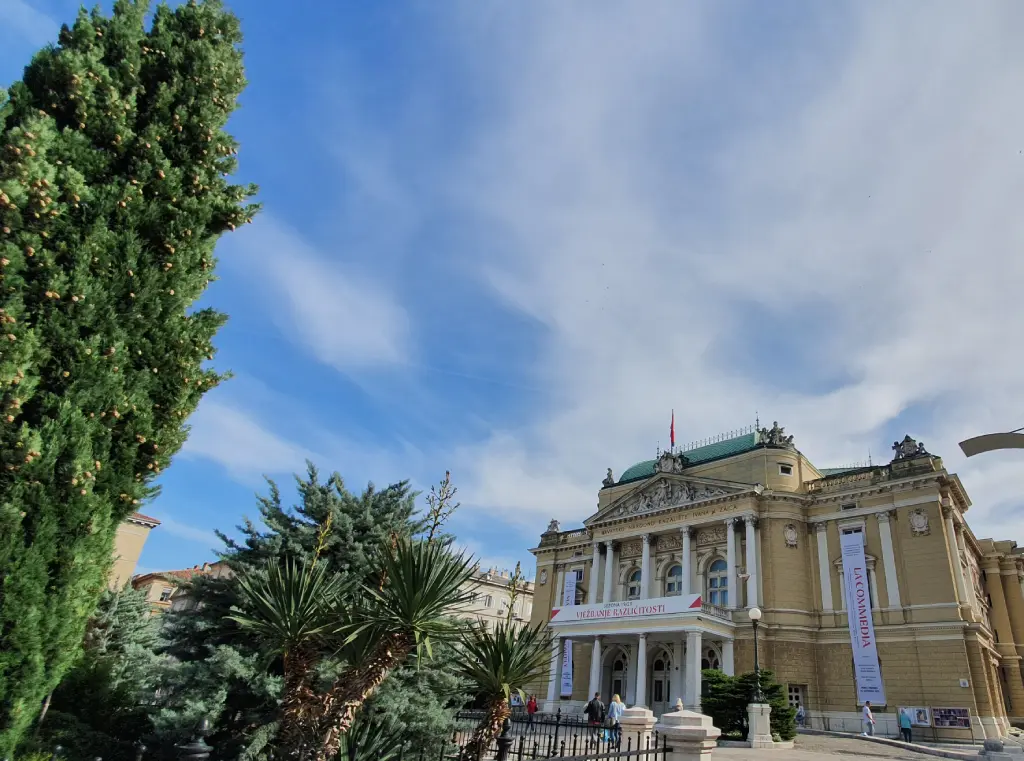
The National Theatre, featuring dance, plays, opera house, ballet house so theatre, is a multi-use venue. The shows should be in either Italian or Croatian, but the most prominent is seeing that in itself. It’s the building and its interior. Make sure to look upward, because the ceiling features are very early frescos by Ernst & brother Gustav Klimpt.
Adress: Uljarska ul. 1, 51000, Rijeka
Putokoza local Tip: When you’re heading to Rijeka, you may want to search the website and see if anything is tickling your imagination. Pre-book tickets will be needed online before entering the performance in Croatian National Theatre Rijeka Ivan Zajc.However, the theatre lovers will like and the other Rijeka theatres: Rijeka City Puppet Theater and the RijekaTheatre.
Rijeka City Puppet Theater
Founded in 1960 under the name of Domino, the theatre got its final name as Puppet Theater later in 1993. Since 1996, the renovated 180-seat building has been hosting local and world literary heritage activities for preschool and school children. GKL Rijeka does not cultivate a specific puppetry technique, but each new title defines a practical puppetry term.
Adress: Blaža Polića 6
Pass the Old Gateway or Roman Arch
Locals claimed for centuries that this archway in the middle of Rijeka was an ancient triumphal Roman arch. Still, it was, in reality, part of the entrance to the former Tarsatica complex. Actually, on the late-Roman defensive fort, Rijeka was later to be built on. It’s the oldest item of heritage on contemporary Rijeka streets. It has been merged between Korzo and the Cathedral by the “Ulica Stara Vrata” buildings on both sides.
Pass through the arch and make beautiful street photography. It looks stunning. Isn’t it?
Visit Modello Palace
The Modello Palace is one of another ornate Austro-Hungarian structure in Rijeka, that will be liked by culture buffs. Situated at today’s area of Brajdica, Modello Palace was built in a period from 1883 to 1885. Its design was made according to the ideas by Fellner and Helmer company. The same architects designed National Theatre Ivan Pl. Zajc. Those were responsible for hundreds of structures in the empire in that period.
The palace was built on the site of the demolished Adamić Theater. It was initially intended for commercial and residential use. Giovanni Ciotta,the mayor of Rijeka at that time, was responsible for constructing the Modello Palace. Memorial to him was made in 1897 by Pietro Zambo. The monumental palace stands out with its elegant stucco façade. The building characterized by Baroque and Renaissance neo style is rich in sculptural reliefs, two-storey pilasters, Corinthian columns and dormer windows. Inside there’s a gala hall filled with a variety of materials such as marble, stucco, panelling, gilding and cast iron. The interior used to serve by Rijeka’s Italian Cultural Club gathers, while the ground floor is Rijeka’s public library.
St. Jerome’s Church and Dominican Monastery
The Church of St. Jerome and the Dominican Monastery are some of the few preserved cultural and historical attractions. The buildings were built by the Duke of Devin’s dukes to serve the Augustinians in 1315. However, the buildings were completed by their successor, Baron Walse. He finished the construction in the 1st half of the 15th century.
Next to the eastern cloister is the Holy Trinity’s votive chapel, which is today a sacristy. It was erected in 1450 by Rijeka captains Martin Raunacher and his wife, Margaret. Their coats of arms can be found on the consoles at the chapel entrance. The remains of frescoes on the Gothic ribbed vault testify to the influence of the Gothic cultural circle. The next, the Chapel of the Immaculate Conception, located along the northern branch of the cloister, was built by Rijeka’s captains Gaspar Rauber and his wife Katarina in the early 16th century. These two buildings are considered the most revered Gothic monuments in Rijeka.
A single-nave gothic church constructed as origin was after an earthquake in 1759 erected and extended towards the west. Its interior and main façade were redecorated in a baroque style. It is decorated with a monumental main altar by the sculptor Antonio Michelazzi from 1744. The altarpiece “The Virgin with St. Jerome and St. Augustine”, a high-quality work by an unknown author dating back to the end of the 17th century. The domestic painter Ivan Krstitelj Cosimini’s valuable work, the “Deputation of Shepherds” from 1687 is valued as one of the numerous Dominican monastery collection paintings. In the monastery cloister, there are 23 sepulchral slabs of Rijeka’s patricians embedded peripherally.
The Capuchin Church of Our Lady of Lourdes
Building back to 1904 until 1929, according to the engineers Giovanni Maria Curet and Cornelio Budinich’s design represents modestly conceived neo-Gothic building. The symbol of “Žabica” would be noticed at a glance from every traveller arriving at Rijeka by bus. The church’s facades what we see today and altar were decorated by the Venetian sculptor Urbano Bottasso and Rijeka’s carver Antonio Marietti. In contrast, the shrine was decorated with polychrome stained glasses. The frescoes inside the interior were painted by the famous Rijeka painter Romolo Venucci.
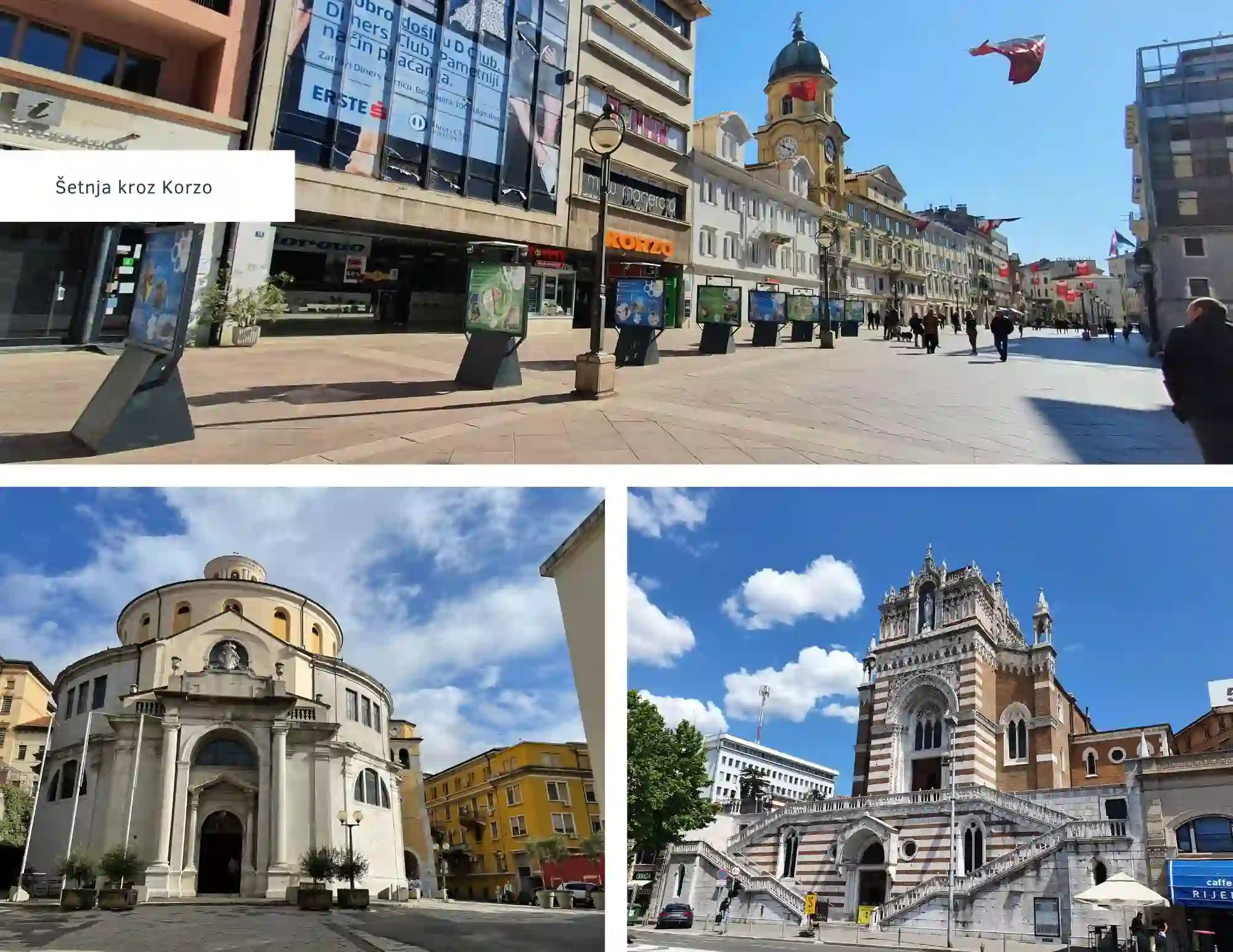
The 75 metres high lighthouse on top of the church should be made on the church. Still, it has never been built, so, unfortunately, I cannot tell how it looks the view from it, since it doesn’t exist. Only I can say to you to imagine it while you look at the church. Even though the lighthouse was not built, the church has become the right signpost for all travellers.
See the only round Cathedral in Croatia – Cathedral of St. Vitus
One will quickly recognize this Baroque Cathedral from the 100 Kuna banknote. It is quite famous for many purposes, but mainly as the only Baroque rotunda of monumental proportions built on Croatian soil.
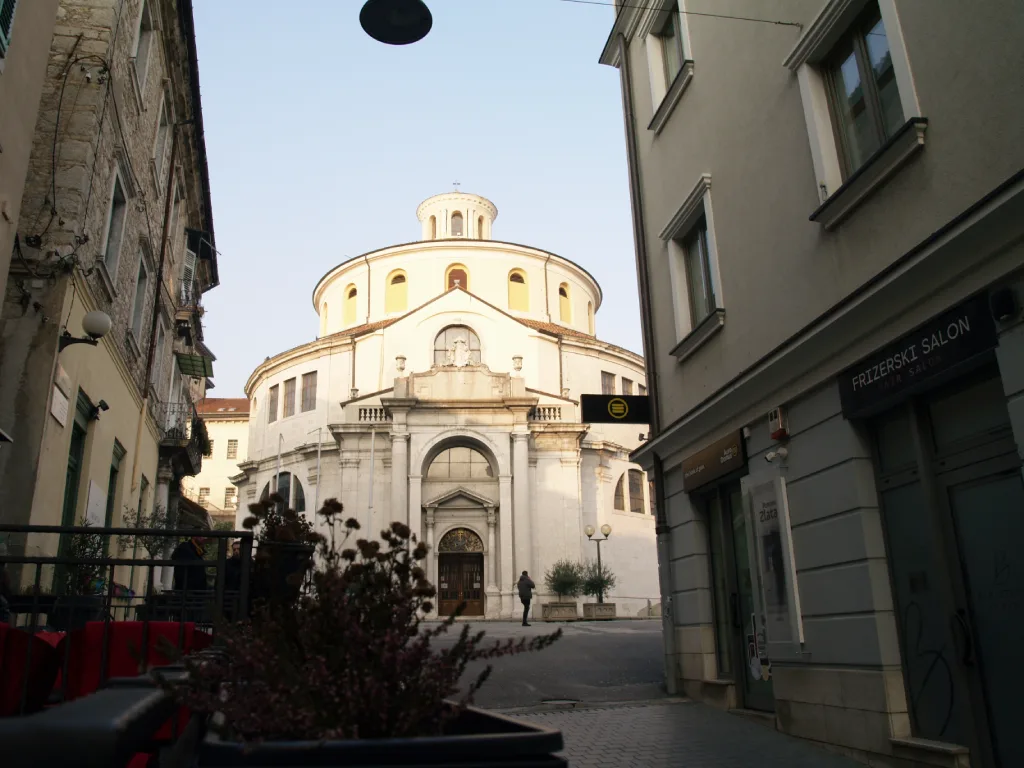
The construction of this church made on the famous Venetian church of Santa Maria Della Salute, and designed by the Jesuit architect G. Briano, began in 1638. It has taken over 100 years to build. Initially, on the location where we see today’s church, a small church of the same name was dedicated to the city’s patron saint. There is also a hidden legend of it. The Miraculous Crucifix started bleeding while a certain Petar Lončarić threw a stone on it, with rage over a gambling loss. The interior lovers will enjoy since inside the church is a true baroque “Gesamtkunstwerk”, a synthesis of the arts. Don’t miss to visit it, since you will also find a portrait of St. Francis Xavier in it, the patron saint of tourists.
Palace of Justice
Constructed in the early 20th century in mainly Art Nouveau style, today’s Palace of Justice looks very impressive on the site of ex feudal castle. It presents monumental rustic building in places even with stylized “cannon holes”. It was designed by the Budapest-born architect G. Czigle supported by architect G. Rubinich, and both architects were keeping masonry style.
Walk across the Breakwater
You simply can not be in Rijeka and miss to walk the breakwater 1707 m length marvellous promenade, that has also been used as a passenger terminal. The current Breakwater in the central port basin is also known by its name as “Molo Longo”, honour to Maria Teresa after the Empress for her historical influence on the city’s development. According to the Hungarian architect Antal Hajnal, a breakwater building performed by a Parisian railway construction company was completed in 1888 since the construction plans, and preparations for it began in 1872.
In the 20th century, the Breakwater was enlarged. A pier used to close the Breakwater was erected in 1908. The final enlargement to the Breakwater was constructed in 1934. During WWII, a range of diversions was conducted Rijeka Port of Rijeka area, damaged due to the German retreat in May 1945. After WWII, while Rijeka was reaching the new development, mostly based on the industrial, pride was placed in the restoration of the breakwater cranes. Take a walk, watch the Adriatic Sea and the island of Cres, find some coffee shop and take a coffee or your favourite drink, while enjoying sitting on the waterfront.
See Peace Ship Galeb
The ship, visible from the waterfront near the city market, is both a symbol and a witness to the political and social history of the 20th century. The ship Galeb (meaning “Seagull”), also known as The Peace Ship Galeb (Brod Mira, Galeb), was designed and launched in 1938 at the Ansaldo Shipyard in Genoa, Italy. Originally built as a cargo ship under the name Ramb III, it was repurposed as a warship during the early stages of World War II, initially serving as a battlecruiser. Following Italy’s capitulation in 1943, German troops took command of the vessel, renaming it Kiebitz and equipping it with tracks for launching mines. The Kiebitz laid over 5,000 mines in the Kvarner Bay and northern Adriatic before being sunk by Allied bombs on 5 November 1944 in the port of Rijeka. In 1947, the ship was salvaged by the Brodospas company from Split.
After renovation at the Uljanik shipyard in Pula, the vessel was commissioned as the Galeb School Ship. In 1953, Yugoslav Marshal Tito made his first international voyage aboard the Galeb to London for a meeting with Winston Churchill. From then on, Tito used the ship as a floating residence, sailing across the world until 1979. During this time, the Galeb welcomed over 100 of the world’s statesmen and women, covering more than 80,000 nautical miles. After Tito’s death, the ship was opened to visitors. In the late 1990s, it was sold to a Greek shipowner, but the vessel was never renovated due to the owner’s bankruptcy. In 2006, the Ministry of Culture declared the ship a cultural asset of the Republic of Croatia. The City of Rijeka purchased it in 2009 with plans to transform it into a floating museum, offering several rooms for overnight stays.
The company Dalmont was selected to carry out the renovation works, which were slated to begin in 2019. Once reconstructed and fully equipped, the Galeb will become a cultural venue in Rijeka. The ship is planned to host permanent museum exhibits, occasional exhibitions, a cinema, and creative workshops. It will also serve commercial purposes, featuring a hostel, bar/restaurant, and a souvenir shop, covering a total of 5,565 m².
Governor’s Palace
This is a brilliant white neoclassical palace from the late-19th century, constructed for the Hungarian governor Lajos Batthyány. It is probably one of the most stunning buildings in Rijeka. Construction of the Governor’s Palace began in 1892 during Governor Lajos Batthyány. The palace design is the leading Hungarian architect of the time, Alajos Haussmann, who had already proved himself on the King’s Palace project and the Budapest Parliament building.
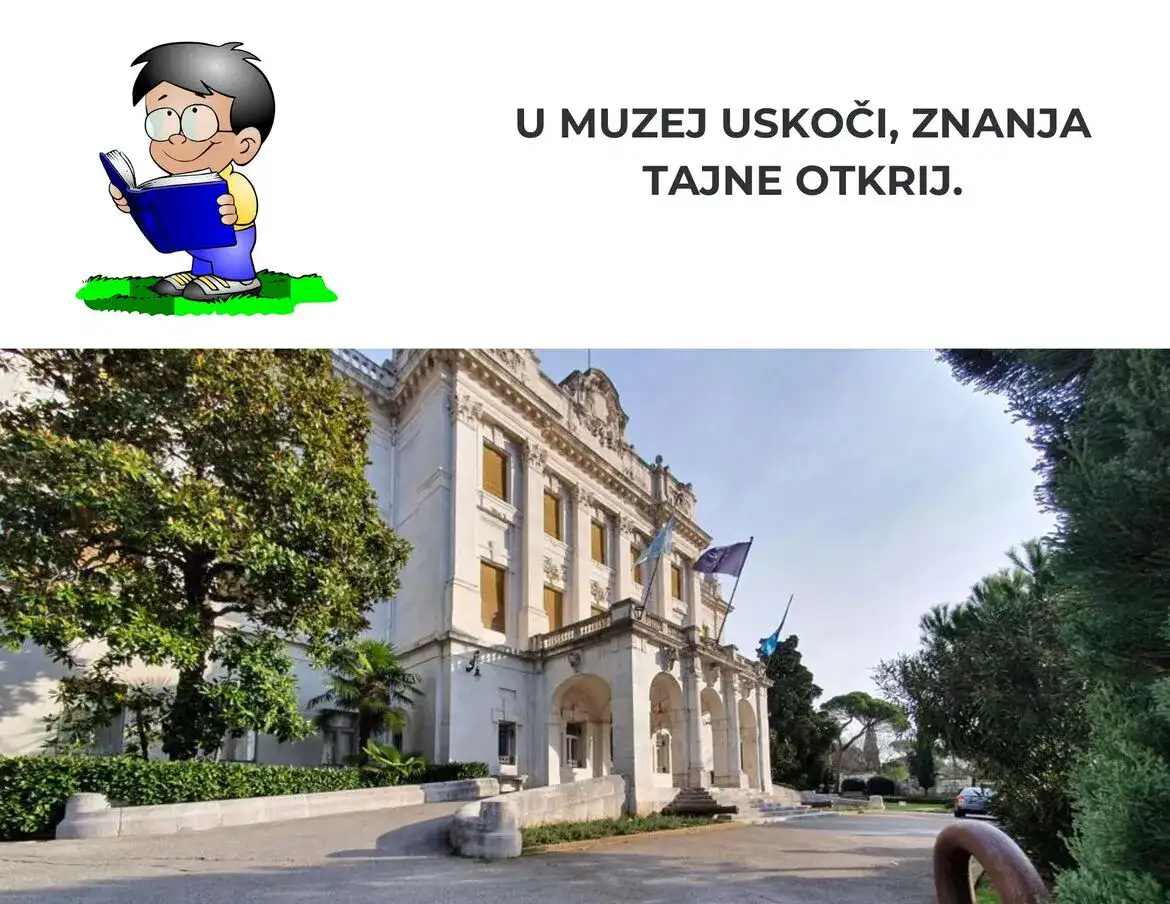
A large and colossal corpus of the separate Neo-Renaissance palace was constructed on a surface area of 12 000 m2 based on models of the famous works of Palladio, a French park with two fountains and balustrades made of wrought iron and two-leaf doors with wardrobes. Today, the Maritime and Historical Museum founded in 1961 of the Croatian Littoral can be found at the palace.
Visit the museums, explore the culture & arts
Since was awarded for being European Capital of Culture (ECC), Rijeka developed more on culture, so their museums are something precious should be looked.
See Torpedo Factory & Museum
One of Rijeka many beams is that it was the place where the torpedo was invented. The tale goes that Ivan Lepps, a former naval officer, sought to think of ideas to protect the coast of Rijeka. He created the self-propelling “Coastal Saviour” in a moment of inspiration. He worked with a British engineer, Robert Whitehead, to construct a prototype. They put their heads together and came up with the prototype “torpedo” by the first tests were made in 1866.
By 1943, the factory located on the western waterfront of Rijeka rolled out torpedoes at a speed of hundreds a month. More accurately it reached its peak output of 160 submarines a month but went into bankruptcy and all that what remained today is a shell of the old Torpedo–Launching Ramp. The town is now making proposals to rebuild the site honoured to its history.
However, the torpedo prototype could be seen in Torpedo Museum in Rijeka situated in the straight centre of Rijeka on Žabica and is practical in the same place as factory location. This very specifical museum is one of the scarce military museums in Croatia. Some prototype of torpedo could also be seen in Zagreb Technology Museum.
Astronomical Centre Rijeka
This unique building, located in a renovated military fortress from the WWII period is on the Sveti Križ Hill in an eastern suburb. It is only one in Croatia that combines a planetarium and observatory. It’s quite a recent attraction. Besides the astronomical significance, the project represents one of the ever most significant investments in Croatia’s technological culture. So far, the observatory has found 2 variable stars. The perfect moment to come for visitors is on Wednesday evenings in the season, when the district-of the-art planetarium shows films in several languages at 10 pm.
Since the centre holds numerous seminars, small events, workshops, and conferences, all the astronomy fans will enjoy a visit. The Rijeka Astronomy Center offers the possibility of hiring a conference room, gaming space, the planetarium, and two terraces – one lower in front of the building’s entrance and one higher, panoramic, on the building’s top. Hire the patio and enjoy the fantastic view while you working or writing the blog.
Peek & Poke Computer Museum
Whether you’re in retro machine hardware and even if you’re not this museum could be interesting to stop by. A timely appeal is one of the very few permanent displays of vintage computing technology, located in the heart of Rijeka. Peek & Poke is a large set of controllers for playing and portable computers from the 1960s. And of course, individuals of all genders, from the Nintendo Wii and the Sinclair Spectrum, would find their favours.
It’s amusing to see them a personal computing chronology up close, to see too many of those vintage machines in working order. Visitors are still welcome to go on any of them and find a library of books and magazines from that era. After all of it is done, you can take a rest in the lounge area, so pushing yourself away can be challenging!
See Carpathia lifejacket in Maritime and History Museum of the Croatian Littoral – Povijesni I Pomorski Muzej.
This attraction is set in one of the most stunning buildings in Rijeka, Governor’s Palace we mentioned above. Established in the 1960s, the museum is managed by many departments: archaeology, ethnography, culture and literature, and maritime exhibits. It won’t be hard to spend a few hours in it since you’ll have an excellent time by researching extensive collections for everything. Those are old coins and maps to coats of arms, antique weapons, navigational devices, toys and even postage stamps. Because this kind of museums is something that I like the most, my recommendation is to visit it if you decide to look at the museums.
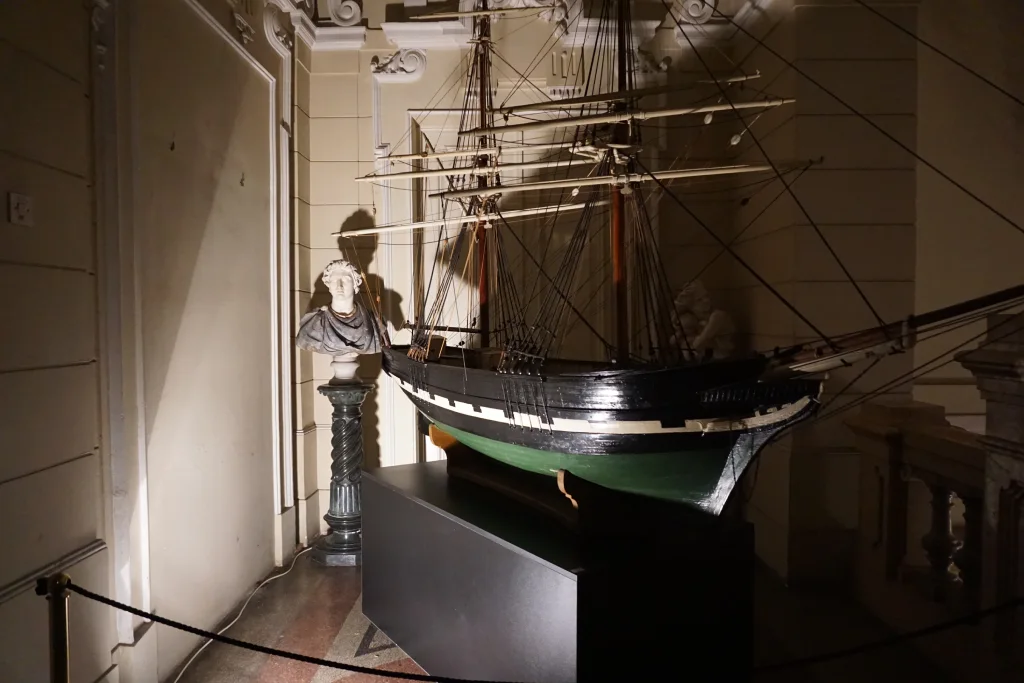
The fascinating item on display in the museum is the Carpathia ship lifejacket. The Carpathia ship had a line connection between New York and Rijeka when RMS Titanic sank (15 April 1912) sailed the treacherous and icy waters to save over 700 people Titanic’s. The lifejacket item in Maritime and Historical Museum of Rijeka is one of only four life jackets taken from the Titanic. It is considered to be the only one in Europe.
Rijeka City Museum
Situated in the building inside the Governer’s Palace yard the building shows exhibits and arts linked to Rijeka and his history. First mentioned in 1875, the City Museum of Rijeka was opened in 1893, and it holds the name Museo Civico. However, the modern museum we see today was founded in 1976. The art and history exhibitions lovers will find themself in looking at the items that most shows Rijeka history and culture in artistic observation.
Natural History Museum
In addition to the botanical garden, the museum is an interactive facility with an aquarium featuring Adriatic Marine creatures. The museum also holds insects, reptiles, birds and amphibians, fish, sharks and sea-rays—ideal programming for kids and adults alike.
Museum of Modern and Contemporary Art
Art buffs would have a lot of fun in this museum that collects artists’ work. The artificials include collections of paintings, sculptures, drawings, prints, posters, photographs, new media art, film and video, and specialized collections. They comprise more than 8000 works, created from the end of the 19th to the beginning of the 21st century.
Rijeka surroundings tours
Yet Rijeka is situated in the centre of the Kvarner Bay, surrounded by mountains of its lands side and the stunning Adriatic Sea with ist islands on the other side. There are potent possibilities for making outdoor tours.
Here we listed the few of ideas of the locations you can visit while in Rijeka. Almost all of them are tourist attractions by itself.
Fill Fabulous in Opatija
The fabulous Opatija, as Croatian singer Ivo Robić, said in its song “Serenade to Opatija” (edition 1949. – 1953.) honoured to it, as the song says it is stunning and beautiful. Situated in the centre of Kvarner bay an elegant spot friendly for families with children, couples and even single travellers is considered the “oldest lady of Croatian tourism”.
With the stunning, illuminated 12-km-long coastal promenade known as the “Lungomare” sea promenade aside from achieving touristic development in the 20th century, Opatija has remained in complete harmony with nature right up until the present day. It’s of well-maintained public gardens, well-kept beaches and fountains. An area provides a stunning backdrop for the villas and hotels that can accommodate up to 6.000 guests. Many of them are from Austrian impact.
Lovran
This picturesque place with a long and diverse past is a hundred-year-long tradition of tourism. It has been developed on the steep eastern slopes of Učka. It is considered the oldest one, founded directly on the coast of Liburnia. Because of the preserved historical core, and the Old Town filled by the courtyards with the water-well in their centrepiece, Lovran possesses that unique charm of Mediterranean townscapes.
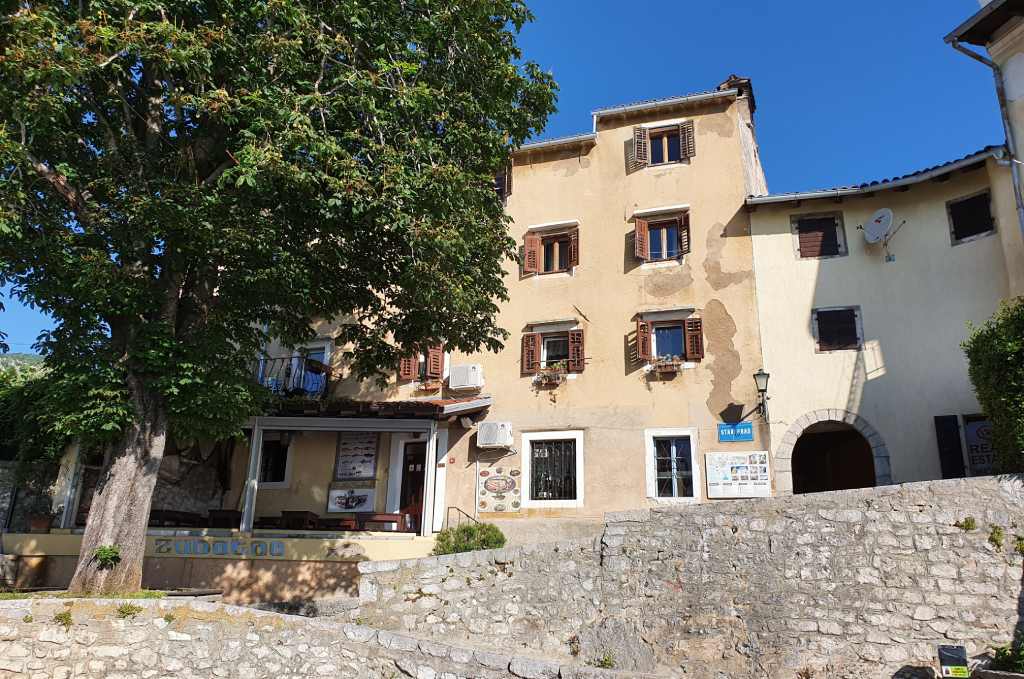
With a mild climate, luxuriant Mediterranean vegetation, Lovran is vibrant, having its colourful façades. Most of them use to be decorated with steps, porches and vaults glanced through stone gates. Eventually, the stunning sea promenade Lovran is a spot you should not miss, while on Kvarner.
Grobnik castle
One of the best-preserved testimony of past times is undoubtedly the Frankopan Castle, situated on a 466 metres high hill, between the left bank of the river Rječina River and the Grobnik Field. Besides to be a historical fort, it offers stunning views. Enjoy the view that extends to Krk, Cres and Učka on northwest and Grobnik Alps northeast, and you’ll notice how that strategic position once it had.
Kostrena
This old seaside town was first mentioned in the early 15th century. Situated next to Rijeka and surrounded by Martinšćica and the long bay, Bakar would be a favourite spot to history enthusiasts. There are twenty settlements, many of which are named after the families used to inhabit them. The area is characterized by karst.
Novi Vinodolski
Situated right in the central part of Northern part of Croatian Littoral, the city is developed from the old fort. The fort used to belong to the noble Frankopan family. Simultaneously, the old part of the town is characterized by the typical littoral Mediterranean architecture. The area amidst various stone buildings among white façades and red roofs is gently rising from the sea level up the hill where the church and the tower seem to watch over their surroundings.
Besides plenty of cultural heritage, the thorp with the absence of industrial pollution is with crystal clear sea andshore. It’s bounded by numerous vineyards, while the fresh mountain breezes blowing gently from the woods into the town. Immediate hinterland not so far from North Velebit national park is an ideal location for the daily tours or holiday.
Smell aromatherapy on Lošinj
Lošinj Archipelago includes the large woody Lošinj, fertile Unije, flowery Ilovik, sandy Susak, and several attractive smaller islands, rocks and reefs the most stunning Kvarner locations. All those who seek tranquillity, nature, aromatherapy, outdoor paradise, and past traces should be stopped here.
Ičići
Situated close to Opatija and once crucial as a Veprinac port for shipping timber, Ičići is a small place today famous by the nautical centre. It’s an exciting step for all those looking and driving on the Kvarner bay from Rijeka direction to Istria.
Mošćenićka Draga& Mošćenice
Situated practical at the end of coastal road from Rijeka direction to Istria, it seems to be a little “separated” from the rest of Kvarner. Still, for tourists, curious visitors, weekend guests, hikers, sportspersons, artists and nature enthusiasts, this place has always been the favourite destination.
What will be for sure real discovery for everyone is a picturesque place Mošćenice situated on the hill above Mošćenićka Draga and bearing the similar name. The view from Mošćenice is very magical, like all the place. You’ll see the small narrow streets, filled with the breath of the past. Yeah, it looks like a great idea to write a blog story dedicated just about Mošćenice, right?
Find the Legend about Kvarner Bay in Medveja
Full of picturesque, small and beautiful sunsets, the once typical fishing village Medveja and today remain peacefully in its surroundings over the years. It is one of my favourite places, and I gladly stop there every time we go hiking on Učka or drive towards Rijeka on this side of the coast. In Medveja, not far from the sea, there is a beautiful climbing spot, making Medveja a favourite of climbers.
Medveja was named after the mythological Greek sorceress Medea. She was the first person to enter the sea from its beautiful and spacious pebble beach. It is said that the Argonauts, the forerunners of the nomadic life, which characterizes most travellers in search for the golden fleece, entered the sea into the Gulf of Kvarner. At the mouth of this legend, here in Kvarner, the victim was the not very well-known hero Apsyrt, whose dismembered body parts of Medea threw into the sea. And yes, that’s precisely the way how itwas created the Kvarner archipelago.
Viškovo
First mentioned as early as in the 16th century, it’s with no doubt specific because of its road that is among the oldest streets in the Kastav area. It was the only road connecting Rijeka, Trieste, Ljubljana, Graz and Vienna. Drive yourself by its road and find the reason was so meaningful.
Jelenje
Distant only for 15 kilometres from Rijeka, on a karst area at an altitude of around three hundred meters of sea level, is the main reason you should make trip or holiday in this Mediterranean-continental climate place. Jelenje is a little but is famous by the tradition of its milkmaids (“Mlikarice”). Those are women who have historically carried milk daily to sell in Rijeka. A special event “A Lantern that has left its mark” (Croatian: “Feral ki Je Pušćal Sinjal”), has been dedicated to them and it has been held every of May. Go up and taste some fresh milk!
Cres
As many times as I go to Cres, I always want to return to it twice as much. Located in the wide Kvarner Bay, Cres is considered the largest Adriatic island, with several climatic and vegetation zones. The island boasts a rare natural phenomenon – a freshwater lake in the island’s centre (Vrana Lake. Not only for outdoor fans, such as Putokoza, for which Cres is a paradise but also for all those who like to enjoy a charming Mediterranean vibe, Cres will be a revelation. I found out on Tramuntana trail, my daily hike tour, starting already by ferry in Porozina. The course is ideal for a day trip from Kvarner or Istria with departure from Porozina, without paying a fee for the car. Since I discovered it has become my hobby once a year.
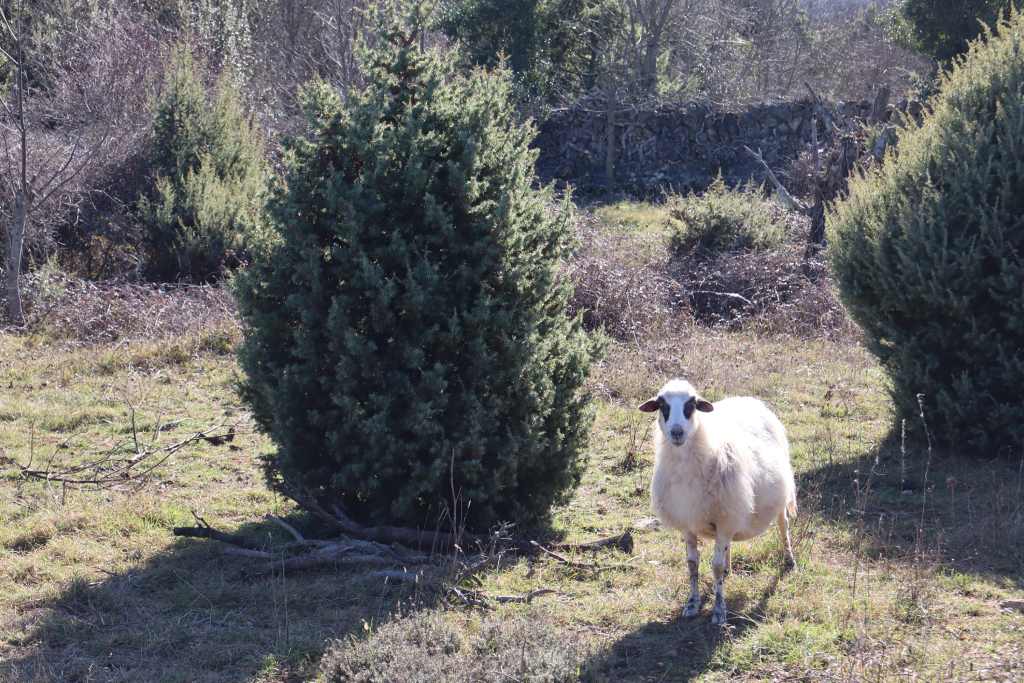
The midpoint of the trail is picturesque Beli. Very scenic small town, situated above the sea looks so mysterious and magical. Ok. It’s not real magic, but let me tell you, it is more of 4000 years old. However, it’s not for sure the only one on Cres since few similar towns on the island such as Lubenice, Pernat or old main town Cres. Sis (639 meters above the sea level), the island’s highest point was for me not less discovery than scenic places. Almost, everyone can do the climb to Sis, even with the children. The ruin on peak evidence that Cres was populated already in the early Stone Age. So don’t wait. Take a ferry from Brestova to Porozina, a small port town, located on the northwest coast of Cres, Croatia.Go to find some sheep, since there is no stress on Cres! Yes, Putokoza like sheep, and we are thankful to share your Cres experience with us.
Kraljevica
Located at the Bay of Bakar’s entrance, right in the heart of the blue Gulf of Kvarner, small and picturesque Kraljevica is surrounded by the sea’s blue and the sky and the green of luxuriant vegetation. In contrast the nature surroundings, Kraljevica is rich in the historical monuments. What I also suggest to see is the scenic “Bakarac”. The photography lovers will enjoy the spots. Go and make some stunning photography to share with Putokoza.
Gorski Kotar
No matter how many times I come to Gorski Kotar, it will always offer an undeniable attraction with the preserved forest areas. The peaks as Snježnik or Risnjak; picturesque valleys such Lazac; many crystal rivers and lakes such as Lokvarsko Lake or Bajer – this is one would expire in that region. Nature reserves; cultural monuments such as Bijele & Samarske Stijene (White and Samar Rocks), Bitoraj, Lokvarska Cave; rural, traditional values, and locals’ warm hospitality.
Nestled between continental Croatia and its coast, whenever Gorski Kotar tour you decide to choose, be sure you’ll enjoy it far away from the hustle and bustle. Each has its own story full of the small scenic places as Fužine, Skrad, Delnice, Prezid, Gerovo, and Ravna Gora. All of them surrounded by stunning woods, so in almost every corner of Gorski Kotar, you can listen to the sound of the wind. If one asks me about the recommendation of visiting Gorski Kotar, I will uncover the fact. Suppose the whole of Croatia is my first choice as a destination. In that case, Gorski Kotar is along with Istria and the beautiful islands of Kvarner, definitely one of my best alternatives in that choice. So don’t hesitate, especially if you’re a fan of outdoor sports. Head off and find some beer in the wood! We already did it!
Klana
Situated in the mountains that border the Gorski Kotar, Klana is a favourite destination for recreational walkers, hikers and cyclists. And not only for them, for Putokoza as also since it is one of them! We like there are arranged and marked biking and walking trails that, together with the historic attractions, make Klana an interesting and recommended spot, of Rijeka Ring. It is a place of beautiful nature and valuable historical monuments, so cyclists or walkers let’s go.
Bakar
Situated in the north-western corner of the magnificent bay that is bearing the same name, Bakar is considered the oldest town in the Northern Adriatic. It is another place on Kvarner I suggest not to miss. With a long and rich history, famous by Maritime School, Bakar is where the Mediterranean Sea soaks deeply into the European continent. The place is shaped in one of the most sheltered bays on the eastern Adriatic coast, which some also call a fjord.
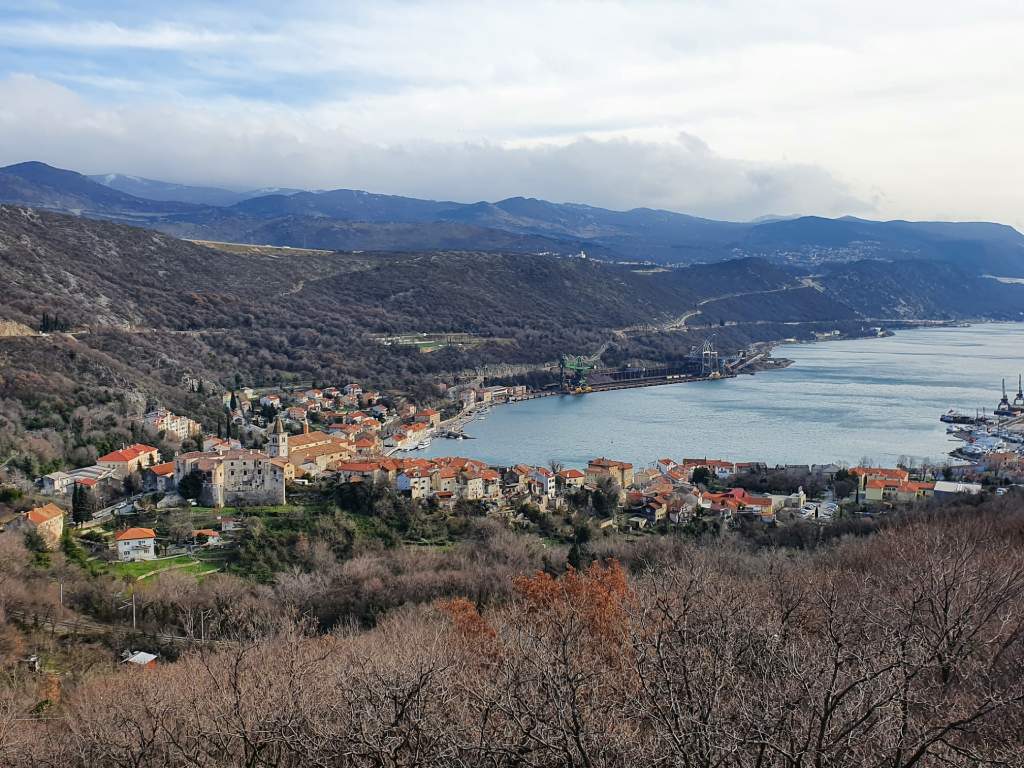
Yes, we travelled Bakar for more times, and even I tried its sea for Regatta with my rowing colleagues. Since the road to Šmrika and Krk from Rijeka has been made, I often miss Bakar, because the journey is longer. However, you shouldn’t miss it.
Istria
Because of the Istrian peninsula is Putokoza home, and we write about it a lot, of course, I couldn’t miss to recommend it on the tours you can do from Rijeka. Being the most prominent Adriatic peninsula and a region of unique blue and green landscapes, alongside a coastline that consists of inlets, beaches and small picturesque historic towns, to mention just the word “Istria” itself shouldn’t be just enough.
Istria has more stories, and you can choose your own. The first thing that makes the peninsula popular is the coastal and picturesque towns such as Rovinj, Poreč or Umag. Furthermore, its southern biggest city of Pula, which has numerous impacts from Austria; last but not least, there are the picturesque central Istrians, surrounded by greenery. Yes, find some giants trails while stopping by in Hum, Oprtalj, Motovun. But not only that. Istria is also a region with a gastronomic arm filled by sea specialities, the mighty truffle, homemade pasta, aromatic herbs and many other delicacies, accompanied by excellent wines and olive oils. Taste someone. Despite the spot, you choose there will be different travel time from Rijeka.
Crikvenica
In contrasts having plenty of opportunities to sunbathe, swim, walk, cycle or enjoy recreational sports, it reflects the valuable historically. The cultural heritage, beautiful natural surroundings, crystal clear sea, fresh air, and traditionally hospitable people all make Crikvenica ideal for balmy, stable and healthy Mediterranean climate seekers. Situated about 40 minutes from Rijeka,Crikvenica also offers events such as the traditional Fishermen’s Week (one of the oldest festivals in Crikvenica), the Aquarium, filled with more than 150 species of fish, the ever-popular.
Krk
Located in the centre of the Kvarner bay, also called Golden Island – “Insula Aurea”, Krk is full of the trails that have been traces of the past. Krk is one of my favourite wander destinations. With the stunning highest mountain summit, Obzovi (570 m), you’ll enjoy in the breathtaking view. Still, in other hands, you might also forget that when you’re actually on an island since it is often very windy spot. The hidden coves as Mala & Vela Luka with the sand, pebble beaches and rocky landscape shore are something that must be discovered while you’re on Krk. And they are full of sheep. Yes, Putokoza likes its friends. Go to find them and follow that uncovered traces.
Besides, to be an outdoor spot, Krk is also a historical island. It’s the place of “Baška Tablet”, one of the first monuments containing an inscription in the Croatian recension of the Church Slavonic language, dating from c. 1100 AD. The charmful places as Stara Baška, Vrbnik and Krk are only a few that I mentioned why touring to Krk. The Island ofKrk is where you can look at the sky full of stars and know what else. Krk has almost become a Penninsula since it’s connected by a bridge from Rijeka. It can be easily reached from Rijeka.
Učka
The mountain that borders Istria and Kvarner is one of the spots I visit a little bit less often than my home. Located along the northern Adriatic coast at one of the most northerly points of the Mediterranean, this park is a true nature paradise. Head along the thick woods, touch its streams flowing over their slopes or find the shelter in some of the hidden convolute trails alongside the mountain. But it’s not only that. You probably didn’t know that Učka is home of pixies.
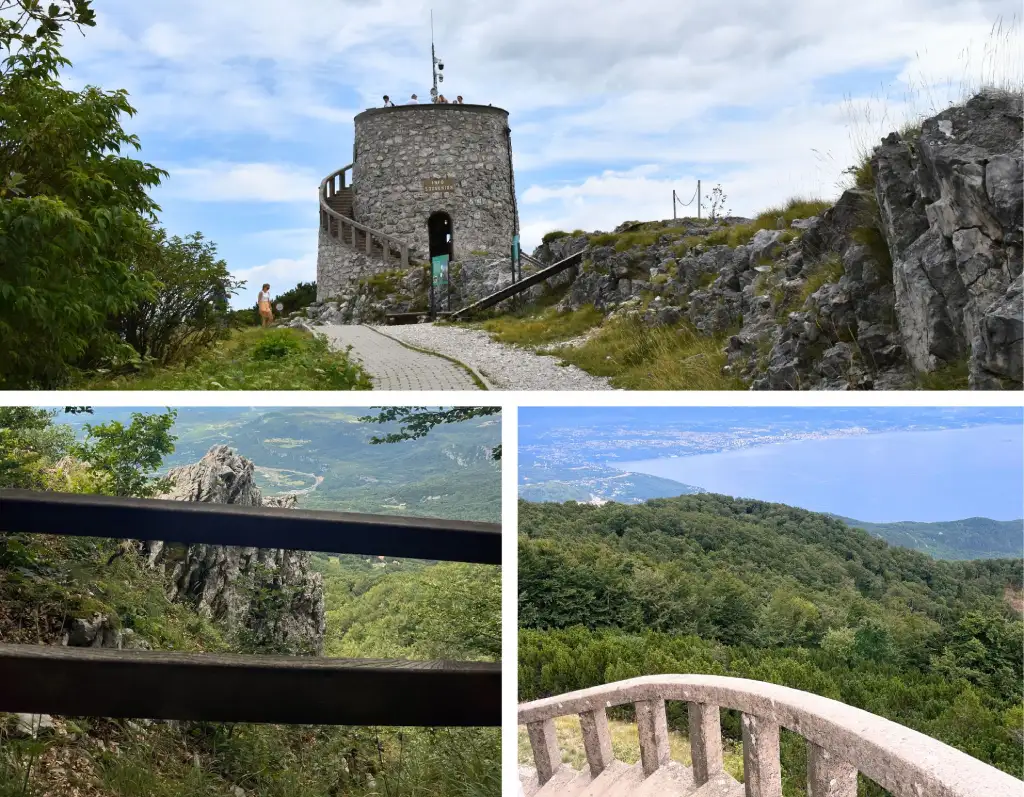
Few of my favourite tracks on Učka are those from Poklon or if the hiking mood is high from Medveja, that we mentioned. But Učka is not only for trailers, but it also’s full of biodiversity. For all of you with the small children there is a marvellous children’s trace nearby Poklon, so if you doubt where to run away from hustle&bustle, don’t think a lot. Učka is always a choice which could never be wrong.
Volosko
OnceVolosko was the district’s seat, an important trade port and the area’s administrative centre before the Opatija was developed onto the touristic destination. Although Volosko has lost that importance, it has retained its magical appeal of a picturesque fishing village. It is an ideal place to find peace and calmness. Yes, we like to walk along the Volosko and “Lungo mare” promenade on its waterfront. Just leave yourself to the harbour’s unique atmosphere and enjoy in the view of the entire Adriatic. If you stop by in it during the windy weather, the visit will be more charmful since you’ll listen to the sound of the sea.
Senj
Though being 76 km distant from Rijeka, driving along the coastline, Senj, the largest urban agglomeration on the Croatian coast between Rijeka and Zadar, is a lovely and picturesque small town. Every time I revisit Senj, I feel myself to be for the first time there. History buffs and the lovers of remote scenic places like me will love it due to location and historical evidence. Located between the Kapela and Velebit slopes overlooking the sea Senj has been for centuries connected with the Mediterranean towns and countries by sea. This tiny town situated under of the most giant mountain in Croatia once had very strategical significance. The most famous monument in it is Nehaj Fort, and I suggest to visit the city for all kind of travellers.
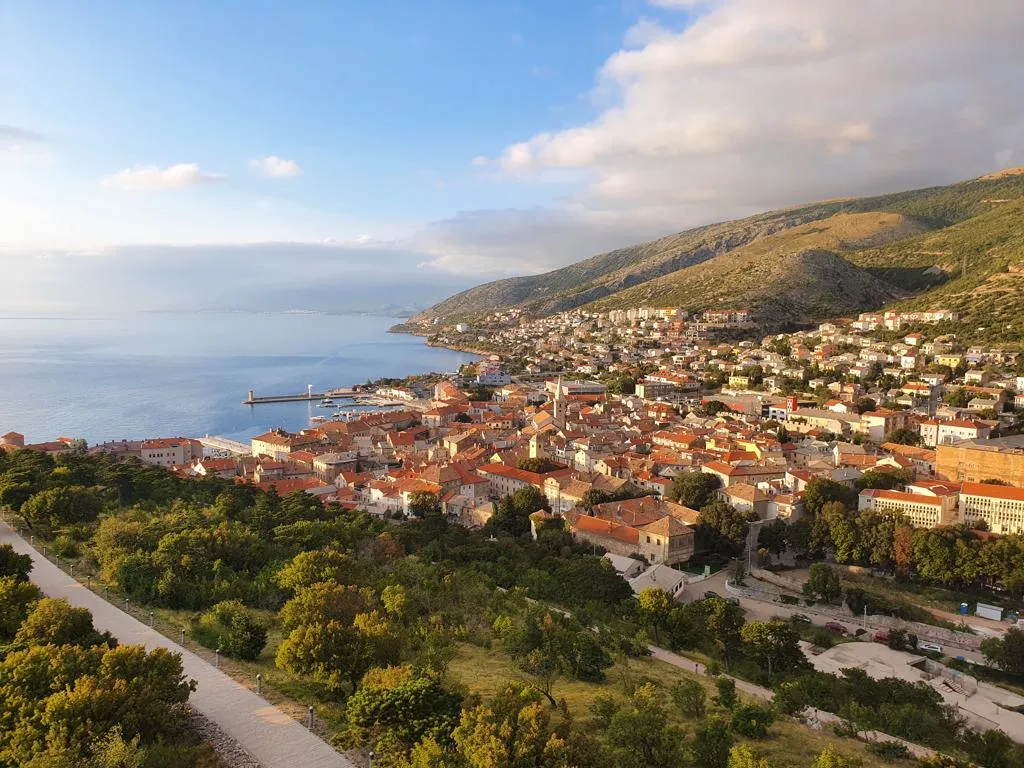
Due to its location on the Eastern Adriatic coast, it is linked with the hinterland by roads leading across the Vratnik pass (700m above the sea level) in the north. The Vinodol Valley and Rijeka are also in the west, Zadar, Split and southern Dalmatia in the south. Senj is our favourite stop since we travel directly to Velebit for a hike, Rab or Zadar along the coastline road of “Jadranska Magistrala.”
Kastav
Distant 10 kilometres up the coast from Rijeka on high ground the little stone town is situated on 365 meters above sea level. If you want to escape from Rijeka, but to see the more of culture than a visit to Kastav is valued, since you can stroll the streets of the 16th century. In reality, many locals come to Kastav during the summertime to enjoy many concerts and festivals held at this scenic location. There are a blues and a guitar festival and the Kastav Summer of Culture that runs through the season.
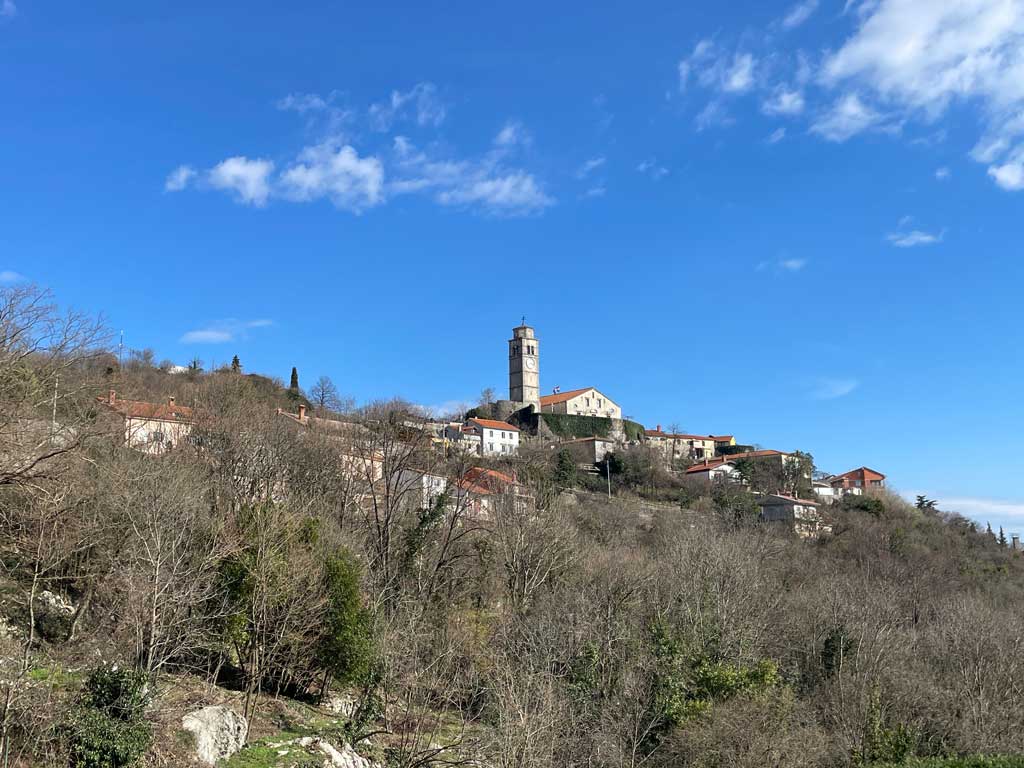
Look out the online sites and see what happens if you stop by. While, in those views that go out to the islands of Krk and Cres, and down to Rijeka, you might only rejoice.
Be active in Rijeka surroundings
Hiking.There are practically unlimited possibilities to hike in Rijeka surroundings since it is situated under the mountain Učka on one side. The other are mountains of Grobnik and Gorski Kotar. Let me mentioned some of my favourite hikes here.
Putokoza Hiking Tip: Učka. 1) From Lovran or Medveja (0 mt) to Vojak (1396 mt). This fascinating trail starts from the sea and rises to the Vojak summit. Because it requires good health and physical preparation.
2)From Liganj (24 mt) or Lovranska Draga (365) to Vojak (1396 mt). The trail from Liganj is practically similar to that one from Lovran, even less short. The route from Lovranska Draga is prevalent. It is one of my favourites since it passes across the very shade forest. You can choose the way nearby mountain hut Babino Sklonište, up on to the climb or back. The view from mountain hut is very stunning since it overlooks Cres Island.
3) From Poklon (917) to Vojak (1396 mt). This is one of the most popular trails used by anyone who needs a good afternoon walk or to catch some fresh air. What I like to do is the circular route, and you can choose more possibilities. However, the trail used to be a little bit steep on some points, and it’s required about one hour and a half till the Vojak.
You can choose the sea, the quarter or the last quarter from the mountain. Still, whenever you decide, nothing compares to the breathtaking, spectacular view extending to the whole Istria and Kvarner with its islands.
4) Lovranska Draga – Draški Slap. This practical walk than the hiking route is ideal for families with children or holidaymakers. During the spring offers the possibility to enjoy in its beautiful waterfalls.
Putokoza Hiking Tip: Hiking to Grobnik Alps. These beautiful mountains are located just above Rijeka. One of my favourite trails is those starting in picturesque village Potkilavac. It leads through the canyon of Mudna Doli or over the ridge above it. You can hike till the scenic small Hahlići Lakes, or if you feel more willing, you can continue till the of “Fratar Summit“ (1353 mt).
Putokoza Hiking Tip: Hiking in Gorski Kotar. Gorski Kotar is as we already mentioned full of trails. In the scenic Fužine, there are various routes one could take. My favourite one heads from a tiny village Vrata up to BitorajPeak. Another trail one could run is along Bajer Lake. The hikers would also enjoy Bijele and Samarske Stijene Peaks (1301 m). Bear in mind that Bijele Stijene nature reserve is deep in the wood, it requires the drive to the start point, requiring the whole day.
Putokoza Hiking Tip: Hiking trail “Platak“. There are very numerous possibilities to hike around Rijeka. But let me just tell you one of my favourites are those from Platak to Risnjak or Platak to Snježnik via “Guslica“ peak.
Putokoza Hiking Tip National Park Risnjak. National park Risnjak is a part of Gorski Kotar. Formed and filled by mountain air bounded with the natural forestwill bevery relaxing therapy for all travellers. The most used trail to reach the Risnjak summit (1528) is from Vilje via Schlosserov Dom.
I like it since the trail is in a big part in the wood. There is also the very interesting “Educational Trail Leska” inside of Risnjak. It’s very unique, and I recommend to visit it since it is an excellent choice to run away from hstle&bustle while in Rijeka.
Rock climbing. There are few hidden locations to practice rock climbing in Gorski Kotar, but what I suggest to enjoy in a beautiful sunny day without while you’re on vacation the rock in Medveja. You can also take a drive till Istria, above Roč. All the routes are signed into the climbing guide.
Cycling. The surroundings of Rijeka offer a varied selection of bicycle paths. Below we will list just a few of the ideas.
Putokoza Cycling Tip: Kastav Wood.Starting in Kastav, this route leads trough Jurdani, Mučići, Mučkov Vrh and offer nice enjoying in nature.
Putokoza Cycling Tip: Ćićarija along the Veprinačka Cesta.This is my favourite in Rijeka surroundings. The whole section is about 22 km long from the road, but you can choose to make a circular and shorter part. The forest passes across the hunting lodge, “Brdo”, belonging to LD “Lane” from Opatija. A few kilometres furthermore there is another similar house Lugarnica “Pilarna” belonging to the Opatija forestry. Use your bike map or the other app you like it.
Paragliding.About 27 km south of Rijeka is a tiny village named Tribalj where you can test your paragliding abilities! If you don’t fear the height too much, then certainly try this unforgettable experience.
Diving. Kvarner Bay was created for discovery. You will find many offers for diving tourism in it.
There is never an end, but sometimes we need to make an end. So read in our other articles about the outdoor experience nearby Rijeka.
Go to the beaches
The bathing season in Rijeka starts in spring and thanks to the Mediterranean climate, lasts until late autumn. On this length of the coast, there are beautiful beaches around Rijeka, two of which fly the Blue Flag, awarded to the best beaches in Europe for requirements which include hygiene and facilities. Both Ploče and Kostanj shingle bays with the clear and crystal blue waters where the could tourists enjoy. There are numerous, diverse, large and noisy, small and secluded, pebbly, concrete, rocky, hidden.
Croatia is a very sporting land. You can find that beaches near Rijeka have volleyball courts and water volleyball equipment, which is great fun in the shallow sea.
Ploče Beach
The beach surrounded by a floating barrier has access to the sea for disabled people, a rescue service, catering facilities, changing rooms, showers, sanitary facilities and a garage. Since it has a beach volleyball court, it’s equipped for water basketball. Ploče has a complex of swimming pools for those who like them, and the most important is a Blue Flag beach.
Preluk Beach
Despite its position in the wind, which blows most of the day, this beach is a true windsurfing paradise. Since it has an entrance for smaller vessels from the land, it is suitable for yachtsmen. There are shower and sanitary facilities on the beach.
Kostanj BayBeach
Another Blue Flag beach is the city beach primarily intended for disabled users. The beach’s safety is very high since the swimming areaisobserved by trained lifeguards. The beach is surrounded by a floating barrier. The beach is equipped for water basketball. Besides the sea access for disabled people, it has catering facilities, showers, and a sanitary facility suitable for disabled persons. There are parking spaces available.
Glavanovo Beach
This pebble beach is very friendly for families with children since it has a shallow sea entrance, and green zone, where you can find some shadow shelter due to high heating days. Since it is characterized by quite a green area, it is also attractive for the more senior visitors. There are shower facilities too.
GrčevoBeach
This another beach equipped for water basketball has a shower and sanitary facilities, catering facilities.
Dog Beach Kantrida
Dog friendly. Located on the east bank of the auxiliary football stadium, next to the parking area this a 500 m2 beach is suitable for all pets. Besides having a shower and tap includes a rubber garden hose for washing dogs. There is also a waste bin with a plastic bag dispenser.
Dog beach Brajdica
Dog friendly. Another beach suitable for dogs is situated at Brajdica in Pećine. This is a sandy beach, equipped with benches, wastebaskets, running water, a tap, shower and a hose. The beach is accessible to both vehicles and pedestrians.
Sablićevo Beach
Distant only a few minutes far from the city centre toward the east it’s considered one of the oldest Rijeka beaches. Young and old will enjoy this pebble beach with a shower, changing rooms and sanitary facilities.
Skalete Beach
This beach is primarily intended for those who prefer sports activities next to the sea. Water-polo players will particularly enjoy the arranged playground. Skalete beach is surrounded by a floating barrier and has a shower and sanitary facilities.
Bivio Beach
This beach has a shower and sanitary facilities, catering facilities and a toboggan.
Igralište Beach
Everyone will enjoy the pebble beach but is particularly friendly for families with children. After sunset, it transforms from a quiet beach in a nightlife place. The beach has parking spaces, a beach volleyball court, catering facilities, a toboggan, shower and sanitary facilities.
The other beaches beyond Rijeka
Above we put a list of beaches where you could get a little bit fresh in the sea without a far away from
driving from Rijeka. I would suggest driving from Rijeka direction north to Brseč, Lovranska Draga and Rabac, or down to south after Senj for those wanting to find something more peaceful rather than a city beach. Since Kvarner is full of hidden coves, which Putokoza is a big fan, follow our other posts to discover them for you!
Shopping in rijeka
Rijeka is a suitable city for shopping. Besides having the biggest City market on Kvarner we already mentioned, Rijeka has a few shopping centres. You will find most of the things you need, including the technics, clothes, sports equipment for hiking and travelling items we like the most.
ZTC centre. Located above Rijeka centre, direction to Kantrida, this centre extended over three floors with Kvarner Bay’s stunning view. It includes 50 different shops. With its appearance, the centre reflects the Kvarner Bay outlines and is divided into two main golden structures.
The Tower Center Rijeka. This modern and elegant shopping centre includes 8 megastores and 150 shops offering clothes and footwear, sports, technology and home furnishings is located directly to south direction Brajdica and Pećine. What we most like is Kibuba, the store with the outdoor equipment. All outdoor lovers will find quality equipment from the few more sports stores what I suggest to look, and one if it is Intersport.
Adress: Janka Polića Kamova 81a
Rijeka events
A lot of them during the year round.
Carnival Parade
The most famous one is The International Carnival Parade Rijeka, one of the biggest Carnival Festivals, renowned as Venice. The festival is held every last carnival Sunday every year, since 1982.
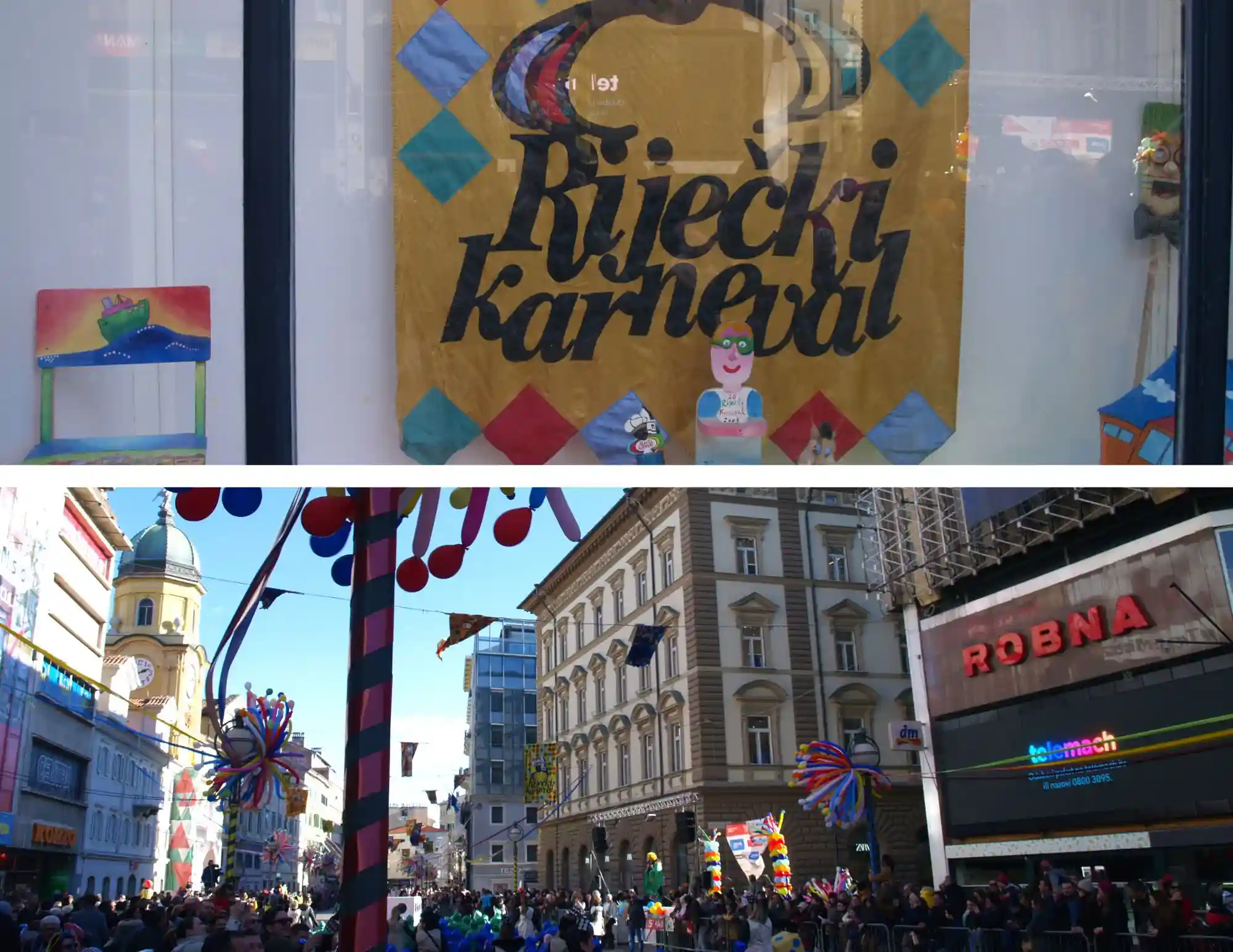
The parade usually took more than 9 hours from start to finish and has over 100 groups featuring over 11,000 people. That day, the whole city, most known for its once bustling shipbuilding and maritime history is extra colourful. You’ll see streamers flapping in the breeze, the balloons on street corners, people wandering about in costumes and music at every turn. The most traditional is probably the bell ringers “Zvončari”, that is UNESCO-listed.
Rijeka nightlife
We suggest a stop to in some of Rijeka Pubs and Bars in the very middle of it. What’s unique about Rijeka nightlife is that there are many offers, and all of them are practical in the circle of the old town. There are various offers. You can find amazing stuff like a bar that serves over 100 different Rakija styles (traditional Croatian brandy), so we recommend to don’t skip a pass. Trsat seems to be great entertainment, especially during the summer, because you can listen to live rock performances from a club with an open terrace and outdoor bar.
🗺️ Getting to Rijeka
📍 GPS: Latitude 45.327065, Longitude 14.442176
✈️ By Air. Rijeka Airport is served by a shuttle bus timed with arrivals and departures. The ride takes you directly to the city centre.
🚆 By Train. Central railway station: King Tomislav Square. Ticket office in the main hall (domestic & international windows).
🚌 By Bus. Main station: Žabica Square, right in the centre. Local stops: Jelačić Square & Delta. Long-distance routes connect Rijeka with all of Croatia and cities like Munich, Trieste, Karlsruhe, Geneva.
⛴️ By Ferry. Port is just 350 m from the city promenade. State lines and limited international routes connect Rijeka with islands and coastal towns.
🚗 By Car. Well-connected with Slovenia and Italy. “Istrian Y” motorway links Rijeka with the Istrian peninsula. Renting a car is often the most flexible option.
🅿️ Parking. Several garages in the city centre. Can be crowded in summer → allow extra time to find a spot.⚠️ Tip: Observe speed limits and expect heavier summer traffic.
📞 Useful Contacts in Rijeka
🚨 Emergency numbers
- 112 – General EU emergency number
- 194 – Ambulance
- 192 – Police
🏥 Hospital. Clinical Hospital Rijeka
💊 24/7 Pharmacies
Rijeka has six pharmacies operating on a 24/7 rotating schedule (not all are open at the same time, but they take turns):
- Pharmacy Korzo – Korzo 22
- Pharmacy Brajda – Krešimirova 24
- Pharmacy Centar – Riva 18
- Pharmacy Kazalištu – Uljarska 3
- Pharmacy Mazzi – Đ. Šporera 3
- Pharmacy Cambieri – Cambierieva 11
ℹ️ Tourist Information Centre. Address: Korzo 14. E-mail: info@visitRijeka.hr

